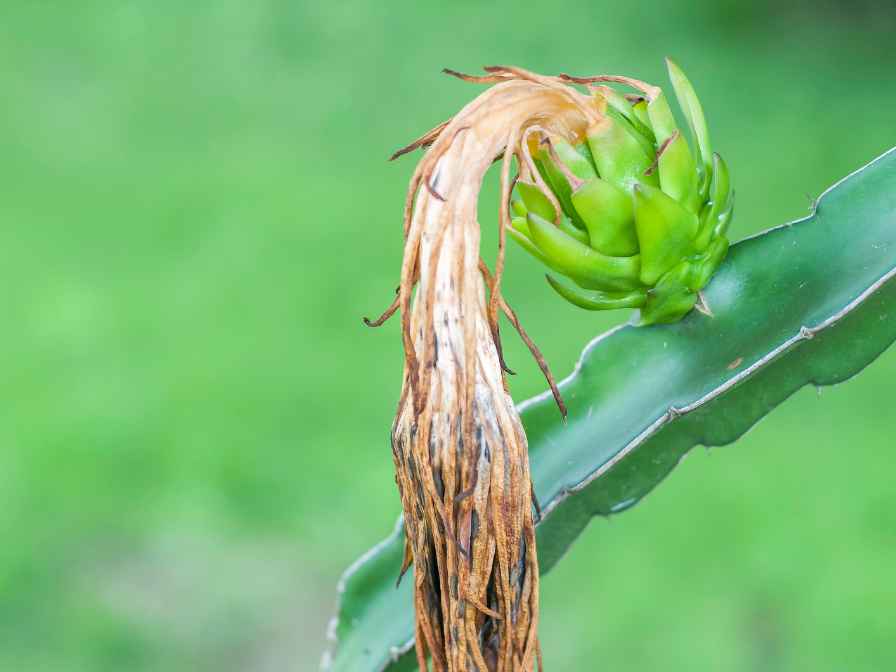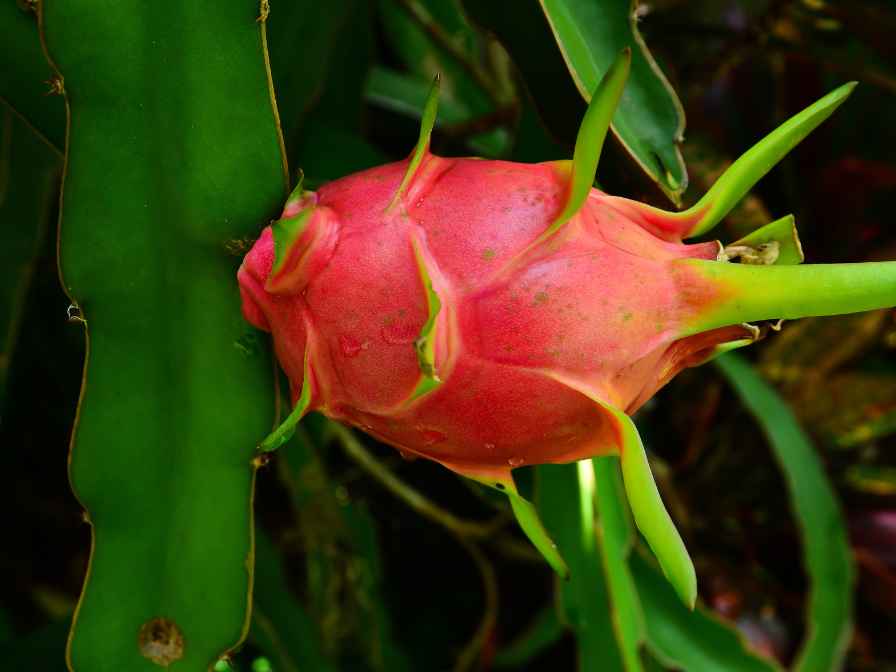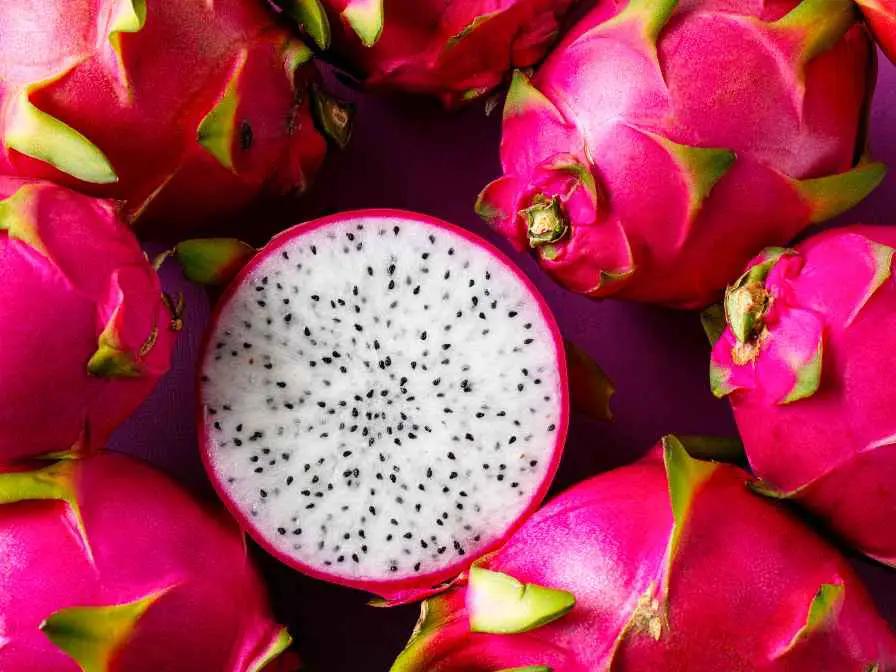People who are involved in gardening to grow healthy and good-looking edible plants. One of these fruit plants is the dragon fruit. This fruit is not only so good looking but also fruit itself has a unique form and shape with a lot of health benefits, that’s why we are going to discuss how to plant dragon fruit.

Dragon fruit plant
Native to central and south America, this fruit is also known as strawberry pear and pitaya. It has bright pink or yellow skin and white or red flesh that is dotted with small black seeds.
The flesh is sweet and slightly crunchy and is often eaten fresh or used in desserts. The fruit contains a good amount of fiber, antioxidants, and vitamin C. It usually needs full sun to grow well. It not only fruits well but also act as a great ornamental plant.
Characteristics of dragon fruit
Dragon fruit has bright pink or yellow skin that is covered in scales or bumps. The flesh is white or red and contains small black seeds. The texture of the flesh is slightly crunchy and the taste is sweet. It has a mixed taste. You will get a mixed flavor of kiwi and pear with a little touch of citrus.
Dragon fruit is rich in antioxidants, Vitamin C, and dietary fiber. It is low in calories and contains small amounts of minerals like iron, calcium, and phosphorous. These vitamins and nutrients provide great energy to the human body.
The fruit is typically harvested when it is fully ripe, at which point the skin should be slightly wrinkled. It takes 2 to 3 years to bear fruit. It has usually an oval or round shape. The dragon fruit can grow up to 7 inches.
It’s also a good source of hydration, with a high water content of about 90%. It’s usually eaten fresh, but can also be used in desserts, smoothies, and salads. You can choose in whatever way you want to eat the dragon fruit.
Benefits of planting dragon fruit
There can be many benefits which are related to the plantation as well as eating the dragon fruit. Some of the important ones are as follows:
Nutritional value
Dragon fruit is a good source of antioxidants, Vitamin C, and dietary fiber. It also contains small amounts of minerals such as iron, calcium, and phosphorus. Once you got the fruit, you got the energy bomb.
Low maintenance
Dragon fruit plants are relatively low maintenance and can be grown in a variety of soil types. They require minimal pruning and are resistant to most pests and diseases. In this way, you can plant it anywhere where it suits you.
Climate adaptability
Dragon fruit plants can grow in a wide range of climates, from tropical to subtropical, making them suitable for growing in many regions around the world. That’s why even if it is not suitable for your area, still you would be able to create it by planting it indoors, in partial shades, or in the greenhouse.
Versatile use
Dragon fruit can be eaten fresh and used in desserts, smoothies, and salads. They can also be used to make jams, jellies, and wine. You can use it in many shapes and forms according to your requirement at the time, or according to your wish.
High yield
Dragon fruit plants can produce a high yield of fruit with each plant producing up to 50 fruits per year. You would not only be able to eat by yourself, but also you can gift these precious fruits to friends and relatives as well.
Aesthetic value
Dragon fruit plants have attractive flowers and fruit, making them a popular choice for ornamental gardening. It is a great addition to the garden. Its presence refreshes the eyes, and when it is fruiting the scene becomes more beautiful.
Sustainable Agriculture
Dragon fruit can be grown using sustainable agriculture practices. They require minimal use of pesticides, herbicides, and synthetic fertilizers. This makes it truly organic fruit, making it popular among many.
Income generation
As it gets a good amount of fruit, the dragon fruit can be sold fresh or processed, it also can be exported to foreign markets. This makes it a potential source of income for gardeners, homesteaders, or for farmers.
How to grow dragon fruit?

To grow dragon fruit effectively, you need to follow some of the basic following steps.
Selection of planting site
Dragon fruit plants need full sun, well-draining soil, and protection from strong winds. It does well in many soils and climates. But make sure the soil is well drained. Do add the compost and other organic matter into the soil, and if you are able to get mall rose of lime, it is good to add that too.
Obtaining and planting cutting/plants
Dragon fruit plants can be propagated from seeds, plants, and stem cuttings. If you have got the seeds you need to put them in tissues and moisten them. In a meantime, these seeds will sprout and you will have to transplant them into the pot. Once these saplings have grown to the plant size plant them at the desired place.
If you have got the plants do go through the same process. Now you have the plants ready to be planted. Just get the place and soil ready for this. Then plant the saplings and tap the soil gently around.
Now coming towards cuttings, cuttings should be about 3-4 inches in length and should have at least 2-3 nodes. Before planting, the cutting should be treated with a rooting hormone to increase the chances of successful rooting.
Plant the cutting in a hole about 6 inches deep, making sure to bury at least 2-3 nodes. The cutting should be planted at a slight angle, with the top node just above the soil surface. Make sure cuttings are healthy. They are in a good shape and form.
Watering and mulching
Water the plants/ cuttings well after planting and keep the soil consistently moist but not waterlogged. A layer of mulch can be added to help retain moisture. It is important to provide a balanced amount of water and moisture to the dragon fruit plants. Excess water can cause root rot in dragon fruit plants.
Provide support
As the plant grows, it will need support to keep it upright. A trellis or stake can be used to support the plant. It’s because the fruit is of good size, and also the fruits are in the good number that’s why you need to make sure that plant has got enough support.
Wait for fruit
Dragon fruit plants will typically begin bearing fruit after 1-2 years. The fruit will typically ripen in about 3-4 months after flowering. Wait for the fruit to ripen enough before plucking it. Don’t hurry, in this way you might end up in wasting the fruit.
Taking care of the dragon fruit plants
Taking care of dragon fruit plants is quite easy. That’s why it is the most preferred fruit plant. It not only takes less attention but also can go on, on its own as well.
Use of fertilizers
Feed the dragon fruit plant with a balanced fertilizer every 4-6 weeks, depending on the growth rate of the plant. You can use OCP seaweed and amino gro for faster growth. However, if you are not able to find it you can use organic compost matter, the dragon fruit plant does best on that also.
Pests and diseases
Dragon fruit plants are relatively resistant to pests and diseases, but it’s still important to monitor for any signs of infestation and take appropriate action if necessary. The caterpillars, mites, slugs, snails, and other might attack the dragon fruit plant. You need to take good action to tackle them.
Fungal problems and root rot might affect the dragon fruit plants. You need to keep a keen eye on the symptoms so that no plant is harmed.
Harvesting dragon fruit

The fruit is typically harvested when it is fully ripe, at which point the skin should be slightly wrinkled and the fruit should pull away easily from the stem. The dragon fruit doesn’t keep ripening after the plucking so do look for the proper symptoms of ripening.
Pick the plucking of dragon fruit accordingly, because you can store it only for 2 to 3 days when it is uncut. So do pluck which is fully ripened and can be used in 2 to 3 days.
In short, the dragon fruit plant is a true blessing of nature. It’s because this plant is adaptive to almost all climate conditions. It not only produces fruit but also adds ornamental value to the place where planted. Moreover, it is easy to take care of.

